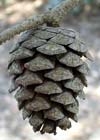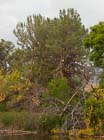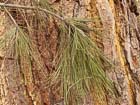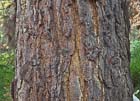Conservation Status

(var. brutia)

(var. eldarica)

(var. pityusa)
Pinus brutia
Ten. (1815)
Common names
Kızılçam [Turkish]; Τραχεία πεύκη [Greek]; Eldar şamı [Azerbaijani]; Сосна пицундская [Russian]; Calabrian pine, Turkish red pine. Calabrian pine is the most common English name, but the species is not native in Calabria (a region in central Italy), a situation rather like that of Norway pine (native to the U.S. and Canada) or cedar of Goa (named for a city in India, native to Mexico). The Turkish name means 'red pine' which, as far as I can tell, is the most common name for a pine in the world, applied to a host of different species (including larches in China!). Var. eldarica is commonly called Afghan pine (though it is not native to Afghanistan), eldarica pine, Eldar pine, and Quetta pine.
Taxonomic notes
Four varieties:
- P. brutia var. brutia.
- P. brutia var. eldarica (Medw.) Silba.
- P. brutia var. pendulifolia Frankis.
- P. brutia var. pityusa (Steven) Silba (syn: P. pityusa Steven).
Vars. brutia, eldarica and pityusa have disjunct distributions and somewhat different ecological settings, in addition to morphological differences. Var. eldarica has also been shown to have some genetic differences, sufficient to indicate a fairly long period of reproductive isolation. It may be more appropriate to treat each of these taxa, and especially eldarica, at subspecies rank. The appropriate names are then Pinus brutia subsp. eldarica (Medw.) Nahal and Pinus brutia subsp. pityusa (Steven) Nahal.
Synonymy: Many synonyms, see POWO. Some authors, particularly within its native range, continue to treat var. eldarica at species rank; less commonly, some authors still treat P. brutia as a variety of P. halepensis.
Pinus × galaiana Papaioannou (1936) is the natural hybrid of P. brutia and Pinus halepensis. It occurs where the two species are sympatric in Turkey, with matings successful when P. halepensis is the pollen donor (but not vice-versa); thus P. brutia populations are introgressed by P. halepensis (Bucci et al. 1998).
P. brutia is a member of Pinus subsection Pinaster, within which it and P. halepensis are sister taxa and also share the most recent common ancestor within the subsection (early to mid-Miocene, according to a molecular clock). They in turn are sister to the clade of P. canariensis + P. pinea + P. roxburghii, with all 5 species sister to P. pinaster (Jin et al. 2021). Plastid data indicate some introgression with P. halepensis in the eastern portion of its range, but it is not extensive; however there is considerable infraspecific variability, with 150 identified haplotypes, only 9 of which are shared with P. halepensis. Nonetheless, 150 haplotypes is a level of diversity consistent with findings for other European hard pines. Of the varieties, only var. eldarica has a clearly discrete haplotype group coupled with a discrete geographic distribution (Kurt et al. 2023). Needle monoterpene profiles show negligible differences between var. brutia and var. eldarica (Michelozzi et al. 2008), but needle flavonoids show substantial differences (Kaundun et al. 1997).
Description
Evergreen trees to 35 m tall, usually with an open crown of irregular branches. Bark first thin, flaky and orange-red, later becoming thick, scaly, fissured, patterned red-brown and buff. Twigs 3-7 mm thick, grey-buff, rough with persistent small decurrent scale-leaf bases. Foliar buds ovoid-acute, with red-brown scales with revolute long free tips, fringed with white hairs. Leaves usually in fascicles of two (occasional trees have mostly 3-leaved fascicles), 5-29 cm long with a persistent 10-15 mm sheath, about 1 mm thick, bright green to yellow-green, margins serrulate, fine lines of stomata on both faces, and several marginal resin canals; leaves are retained for 1.5-2.5 years. Juvenile leaves 1.5-4 cm long, glaucous, borne on plants up to about 4 years old, though adult leaves are borne from about 1 year onward. Seed cones erect to forward-pointing on short stout peduncles, symmetrical, broad conic, (4-)6-10(-12) × 4-5 cm when closed, first green, maturing shiny red-brown in April two years after pollination and opening in summer or up to 2 years later, 5-8 cm wide when open; the seeds are often not shed until winter rain softens the scales. Seed scales short, broad, thick, woody, very stiff; apophysis 10-15 × 15-20 mm, rounded with a slight to moderate transverse ridge; umbo dorsal, flat to slightly raised, 5-7 mm wide, gray-buff. Seeds gray-brown, 7-8 × 5 mm with a broad, auricled 15-20 × 10 mm wing, yellow-buff and streaked darker brown (Frankis 1993). See García Esteban et al. (2004) for a detailed characterization of the wood anatomy.
Key to the varieties of Pinus brutia (Farjon 2010):
| 1. | Ovoid-globose seed cones with pale gray, slightly raised apophyses. | var. eldarica |
| 1. | Ovoid-conical seed cones with red-brown apophyses. | 2. |
| 2. | Leaves drooping, 18-29 cm long. | var. pendulifolia |
| 2. | Leaves spreading, <18 cm long. | 3. |
| 3. | Leaves 10-18 cm long. | var. brutia |
| 3. | Leaves 5-9 cm long, stiff. | var. pityusa |
| | | |
P. halepensis and P. brutia var. eldarica have a very similar appearance in habitat. P. brutia var. eldarica has a significantly shorter cone peduncle (2.5 vs. 11 mm), longer needles (11 vs. 6.5 cm), and cones strongly pointing toward branch tip (vs. pointing somewhat towards branch base in P. halepensis). In overall form, P. brutia var. eldarica has more erect growth with a more uniform and more dense crown, while P. halepensis commonly has a less erect and more open crown (Ritter n.d.). The species have disjunct ranges, but co-occur in some areas where planted or naturalized.
Distribution and Ecology
Armenia, Azerbaijan, Cyprus, Georgia (including Abkhazia), Greece, Iran, Iraq, Israel, Lebanon, Syria, Turkey, Ukraine, Russia; but it is most abundant, by far, in Turkey. A 1987 survey found natural stands covering a bit more than 30,000 km2 in Turkey, with about 87% near the Mediterranean coast, 10% in the interior, and 3% near the Black Sea coast. The bulk of these forests are on the seaward slopes of the Taurus Mountains from sea level to about 1300 m elevation (Eron 1987). Pantelas (1986) reported that P. brutia is also by the principal forest species on Cyprus, accounting for 90% of forest cover from sea level up to about 1600 m elevation, covering about 1750 km2; about 25% of the area is subject to exploitation for saw timber, chipboard, charcoal and other minor wood products, while about 4% of the area is set aside in reserves. Besides its native occurrence, P. brutia has also been introduced since very early times (B.C.E. in Italy) to all Mediterranean countries (except Malta), Afghanistan, and Pakistan as an ornamental and/or forestry plantation species, and is likewise so used in Australia and the United States (Fisher et al. 1986).
Distribution of the Mediterranean species of subsect. Pinaster. Polygons provided by Caudullo et al. (2024). P. brutia shown in green (var. brutia), blue (var. eldarica), and orange (var. pityusa). Click on any polygon to see the species represented.
In habitat, most populations are near marine coasts at 0-1500(-1650) m elevation, in areas with a strongly Mediterranean climate (i.e., hot dry summers and cool moist winters) with annual precipitation of 400-1300 mm. Soils are highly variable, but the species seems to do best on moderately alkaline carbonate-derived soils, a situation seen much more often in Juniperus than in Pinus. Compared to P. halepensis, P. brutia has lower drought tolerance and better cold tolerance. It can form extensive pure stands, or mixed stands with Cupressus sempervirens or Juniperus excelsa, or mixed woodland with Quercus coccifera, Q. calliprinos, Pistachio lentiscus, or other drought-tolerant trees. Most stands of this shade-intolerant tree regenerate after fire, and regeneration is only from seed; moreover, most fires occur in the summer, and most seed dispersal also occurs in summer (August to October), so there is generally adequate seedfall to initiate regeneration almost immediately after fire. Regeneration starts with the fall rains and continues into spring. Also, low-elevation stands produce substantial seed crops almost every year, though mountain stands follow the usual pattern in conifers of producing large seed crops only every few years. P. brutia is an unusual conifer in that it can successfully invade maquis (chaparral) vegetation, given a long enough fire-free interval. Although plantations of P. brutia typically have a depauperate understory, native stands in habitat can have a diverse flora of shrubs and herbs, and provide important wildlife habitat (Eron 1987, Farjon 2010, Chambel et al. 2013).
Bioclimatic modeling for the species within Turkey suggests that P. brutia is likely to benefit slightly from climate change forecast to occur between now and 2100, with a 5-10% increase in the extent of suitable habitat (Arslan et al. 2025).
Hardy to Zone 7 (cold hardiness limit between -17.7°C and -12.2°C) (Bannister and Neuner 2001). However, this varies greatly with provenance, and Chambel et al. (2013) cite a provenance trial that endured over 2 weeks of temperatures below -24°C.
The type variety occurs in Cyprus, Greece, Israel, Lebanon, Syria, and Turkey, and conforms closely to the ecological description above. Due to its broad distribution with many discrete populations it is of "Least Concern" for conservation.
Var. eldarica occurs in Armenia, Azerbaijan, Georgia, Iran, Iraq, and possibly extreme SE Turkey (Caudullo et al. 2017), although a very different perspective comes from Farjon (2013a), who asserts it is endemic to a single population on Mt. Eilyar-Oyugu in Azerbaijan. It experiences a different climate than the other species, featuring wet summers and particularly cold winters. It has been introduced all across Central Asia due to its drought and cold tolerance; it is naturalized at locations east through Iran and Afghanistan to Pakistan (Frankis 1993, Vladimir Dinets e-mail 1998.01.12). The variety was assessed as "Near Threatened" in 2011 (Farjon 2013a) for reasons that are unclear, since, if it does persist only as a single isolated population, it is extremely vulnerable to stochastic events.
Var. pendulifolia occurs scattered in southwest Turkey mixed with the type variety (Frankis 1993). Its conservation status seems not to have been assessed.
Var. pityusa is found in Georgia (including Abkhazia), Russia, and Ukraine, near the Black Sea coast (Frankis 1993, Vladimir Dinets e-mail 1998.01.12). It was assessed as "Vulnerable" to extinction in 2011 because although it is found along much of the north coast of the Black Sea, its area of occupancy is likely less than 1000 km2 and it is vulnerable to coastal development (Farjon 2013b). As of 2025, it is likely also vulnerable to collateral effects of the ongoing Russia-Ukraine war.
Some trees have cones which do not open widely even after prolonged weathering, so the seeds are incapable of normal wind dispersal. This form is probably dispersed by Krüper's Nuthatch Sitta krueperi (Frankis 1992).
Remarkable Specimens
A tree in the Hermon Mountains of Israel is 35 m tall; taller trees may occur in Turkey. One at Kemer, near Fethiye, SW Turkey, is 210 cm dbh (H. Karaca measurement, in litt. to M.P. Frankis, 1994). The largest representative of var. pityusa is in Pitsunda Nat. Res., Abkhazia.
The oldest known living specimen, 317 years, was documented in a tree-ring chronology covering the period 1584-2002 (fully crossdated), collected at 1550 m elevation near Mt. Olympos on Cyprus by R. Touchan and M. K. Hughes (doi.org/10.25921/5nbm-rb05).
Ethnobotany
A sap-sucking insect Marchalina hellenica produces large amounts of honey-dew, harvested by honeybees and sold as 'pine honey' (Gounari 2006). Pinus brutia was planted outside its native range in Greece from early times for this harvest (G. Schiller, 1993, pers. comm. to M.P. Frankis). Even today, P. brutia is harvested for its resin in Greece, where it is used to make the pine-flavored wine retsina (Chambel et al. 2013). The resin is also tapped by native people in areas of western Turkey, who process it and sell it in local markets as a medicine for stomach and intestinal wounds. People chew it to relieve coughing, clean the teeth, and treat bad breath; and it is applied to skin injuries such as boils and cracking skin of the feet (Satil et al. 2011).
This is the most important forest tree in the north-eastern Mediterranean area, planted widely for timber production. It is a particularly common plantation species in Afghanistan, Iran, Iraq, Pakistan, and Turkey (Fisher et al. 1986). Many provenance studies have been done to enable optimum choice of seed for planting, even in such far-flung areas as New Mexico and Western Australia (Fisher et al. 1986, Chambel et al. 2013), and the hybrid with P. halepensis has been found to be particularly productive in areas with severe drought stress, because it displays different drought tolerance strategies inherited from each of the parent species (Houminer et al. 2022).
Pinus brutia has been used in a number of dendrochronological investigations, such as a study of climate change in Azerbaijan (Mammadov and Ashrafova 2022) and a study of growth suppression due to defoliation by a pest insect (Carus 2004).
Observations
No data as of 2023.11.03.
Remarks
The species was early introduced to the Italian province of Calabria (in Roman times: Brutia, the origin of the specific epithet) (Farjon 1984). In Greek it is known simply as Πίτυς (pitys), pine; this name is also applied to P. halepensis. There are a number of tales in Greek mythology that describe a nymph who was changed into a pine in order to escape the unwanted attentions of a god (variously Pan, Dionysius, or Boreas).
Citations
Arslan, E. Seda, Ömer K. Örücü, Süleyman Gülcü, Samet Dirlik, and Ecem Hoşgör. 2025. Prediction of the shift of the distribution of Pinus brutia Ten. under future climate model. New Forests 56(2):25. doi.org/10.1007/s11056-025-10092-y.
Bucci, G., M. Anzidei, A. Madaghiele, and G. G. Vendramin. 1998. Detection of haplotypic variation and natural hybridization in halepensis‐complex pine species using chloroplast simple sequence repeat (SSR) markers. Molecular Ecology 7:1633-1643.
Carus, S. 2004. Impact of defoliation by the pine processionary moth (Thaumetopoea pityocampa) on radial, height and volume growth of Calabrian pine (Pinus brutia) trees in Turkey. Phytoparasitica 32:459-469. doi.org/10.1007/BF02980440.
Caudullo, G., E. Welk, and J. San-Miguel-Ayanz. 2017. Chorological maps for the main European woody species. Data in Brief 12:662-666. https://doi.org/10.1016/j.dib.2017.05.007.
Chambel, Maria Regina, Jose Climent, Christian Pichot, and Fulvio Ducci. 2013. Mediterranean Pines (Pinus Halepensis Mill. and Brutia Ten.). Pp. 229-265 in Forest Tree Breeding in Europe, edited by Luc E. Pâques. Dordrecht: Springer Netherlands. doi.org/10.1007/978-94-007-6146-9_5.
Conkle, M. T., G. Schiller & C. Grunwald. 1988. Electrophoretic analysis of diversity and phylogeny of Pinus brutia and closely related taxa. Systematic Botany 13: 411-424.
Eron, Z. 1987. Ecological factors restricting the regeneration of Pinus brutia in Turkey. Ecologia Mediterranea 13(4):57-67. doi.org/10.3406/ecmed.1987.1189.
Farjon, A. 2013a. Pinus brutia var. eldarica. The IUCN Red List of Threatened Species 2013: e.T34183A2849651. https://dx.doi.org/10.2305/IUCN.UK.2013-1.RLTS.T34183A2849651.en, accessed 2025.02.04.
Farjon, A. 2013b. Pinus brutia var. pityusa. The IUCN Red List of Threatened Species 2013: e.T33990A2839662. https://dx.doi.org/10.2305/IUCN.UK.2013-1.RLTS.T33990A2839662.en, accessed 2025.02.04.
Fisher, James T., Robert W. Neumann, and John G. Mexal. 1986. Performance of Pinus halepensis/brutia group pines in southern New Mexico. Forest Ecology and Management 16:403–410. doi.org/10.1016/0378-1127(86)90036-8.
Frankis, M.P. 1992. Krüper's Nuthatch Sitta krueperi and Turkish Pine Pinus brutia: an evolving association? Sandgrouse 13: 92-97.
Frankis, M. P. 1993. Morphology and affinities of Pinus brutia. Pp. 11-18 in O. Tashkin (ed.) Papers International Symposium Pinus brutia. Marmaris / Ankara.
Gounari, S. 2006. Studies on the phenology of Marchalina hellenica (gen.)(Hemiptera: Coccoidea, Margarodidae) in relation to honeydew flow. Journal of Apicultural Research 45(1):8-12.
Houminer, Naomi, Joseph Riov, Menachem Moshelion, Yagil Osem, and Rakefet David-Schwartz. 2022. Comparison of morphological and physiological traits between Pinus brutia, Pinus halepensis, and their vigorous F1 hybrids. Forests 13(9):1477. doi.org/10.3390/f13091477.
IUCN. 2006. Pinus brutia. https://www.iucnredlist.org/search/details.php/33990/all, accessed 2006.11.01, now defunct.
Kaundun, S. S., B. Fady, and P. Lebreton. 1997. Genetic differences between Pinus halepensis, Pinus brutia and Pinus eldarica based on needle flavonoids. Biochemical Systematics and Ecology 25(6):553-562.
Kurt, Yusuf, Burcu Cengel, Ercan Velioglu, Santiago C. Gonzalez-Martinez, Delphine Grivet, and Nuray Kaya. 2023. Chloroplast microsatellite diversity of Pinus brutia Ten. and Pinus halepensis Mill. populations across the Mediterranean Basin: inferences of their distributions. Forest Systems 32(2):e008. doi.org/10.5424/fs/2023322-19729.
Mammadov, T., and Sh. Ashrafova. 2022. Climate Change Impact on the Absheron Peninsula Vegetation. Bulletin of Science and Practice 8(5):102-111. https://doi.org/10.33619/2414-2948/78/12.
Michelozzi, M., R. Tognetti, F. Maggino and M. Radicati. 2008. Seasonal variations in monoterpene profiles and ecophysiological traits in Mediterranean pine species of group “halepensis”. iForest-Biogeosciences and Forestry 1:65-74. Available http://www.sisef.it/iforest/pdf/?id=ifor0206-0010065, accessed 2013.11.25.
Pantelas, V. 1986. The Forests of Brutia Pine in Cyprus. Options Méditerranéennes: Série Etudes, pp. 43–46.
Papaioannou, J. 1936. Forstwissenschaftliches Centralblatt 59:194.
Ritter, Matt. [no date]. Pine trees (the genus Pinus). https://static1.squarespace.com/static/562016f1e4b0dc6edcb66948/t/5787faebd2b857a47c4f795f/1468529417903/Pinus+Lecture.pdf, accessed 2024.01.15.
Satil, Fatih, Selami Selvi, and Rıdvan Polat. 2011. Ethnic uses of pine resin production from Pinus brutia by native people on the Kazdağ Mountain (Mt. Ida) in western Turkey. Journal of Food, Agriculture and Environment 9:1059-1063.
Tenore, M. 1815. Flora Napolitana 1: LXXII.
See also
The species account at Threatened Conifers of the World.
Caraglio, Yves. [no date]. Mediterranean Pines and Cedars. amap.cirad.fr/Pines_cedars/species/pinbrut_archi.html (accessed 2006.11.01). This page describes the "Morphology and architecture of Pinus brutia."
Ali Kavgaci, Urban Šilc, Saime BaŞaran, Aleksander MarinŠek, Mehmet Ali BaŞaran, Petra KoŠir,
Neslihan Balpinar, Münevver Arslan, Özge Denli, and Andraž Čarni. 2017. Classification of plant communities along postfire succession in Pinus brutia (Turkish red pine) stands in Antalya (Turkey). Turkish Journal of Botany 41:299-307. Available http://journals.tubitak.gov.tr/botany/issues/bot-17-41-3/bot-41-3-8-1609-34.pdf, accessed 2017.09.04.
Ne'eman, Gidi and Louis Trabaud (eds.). 2000. Ecology, Biogeography and Management of Pinus halepensis and P. brutia Forest Ecosystems in the Mediterranean Basin. Leiden: Backhuys. 407 pages, ISBN 90-5782-055-2.













